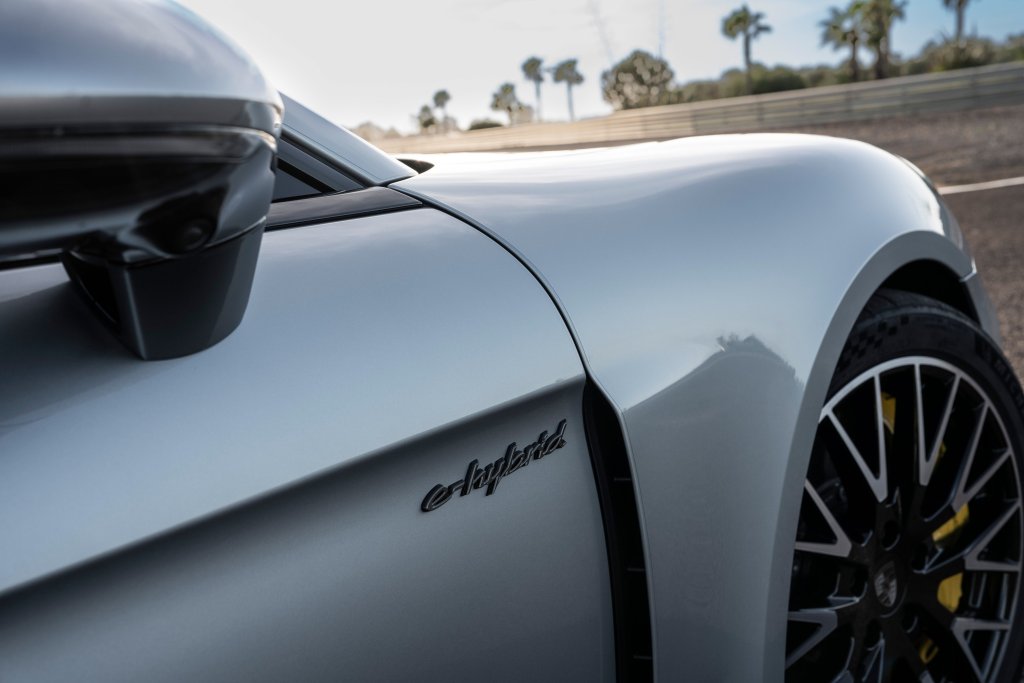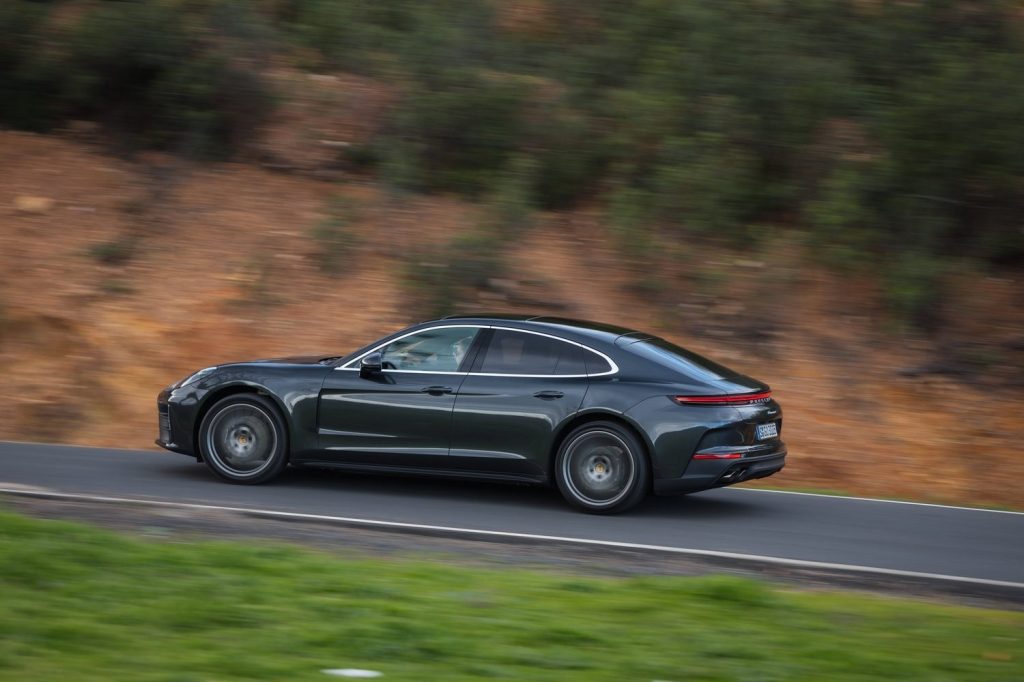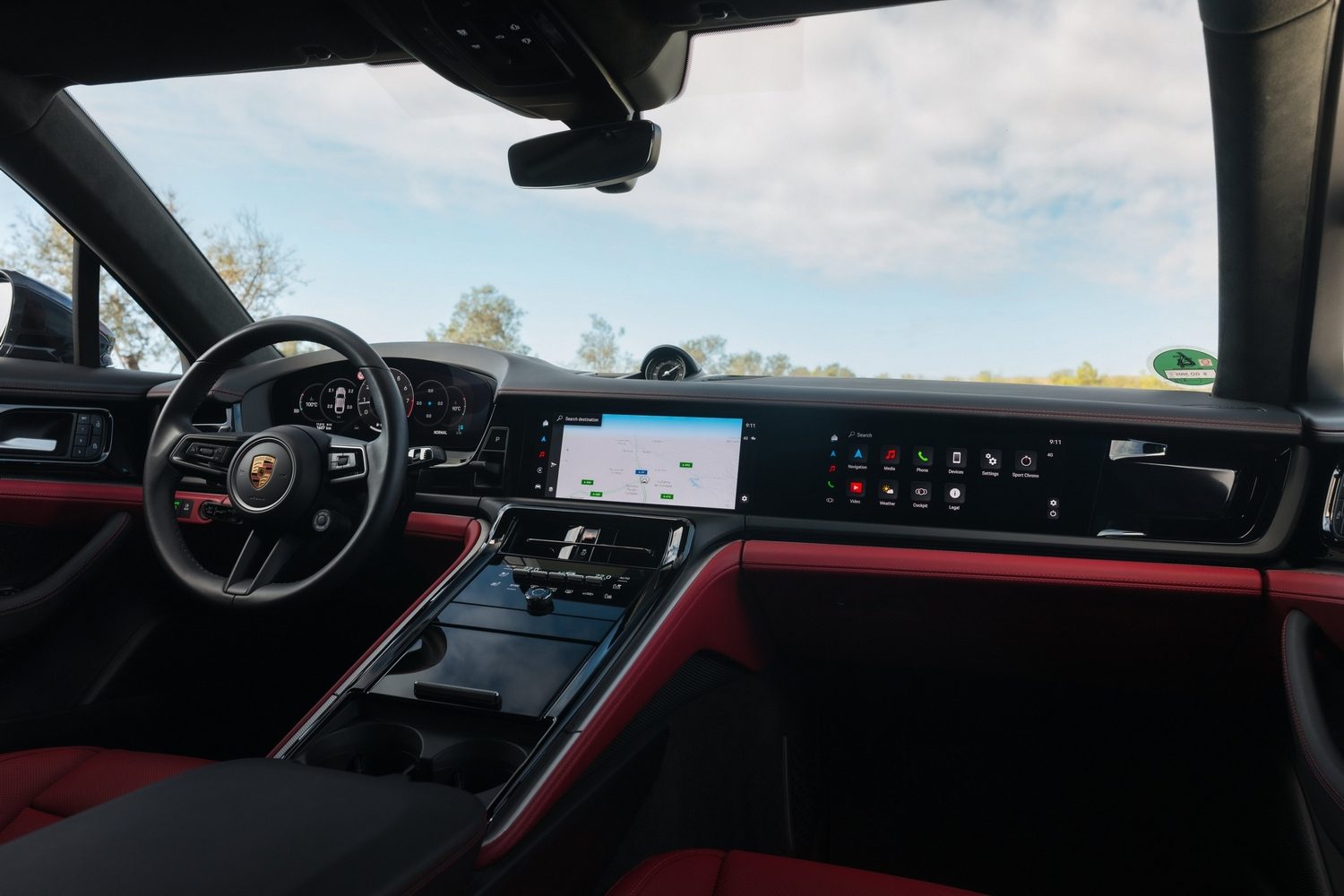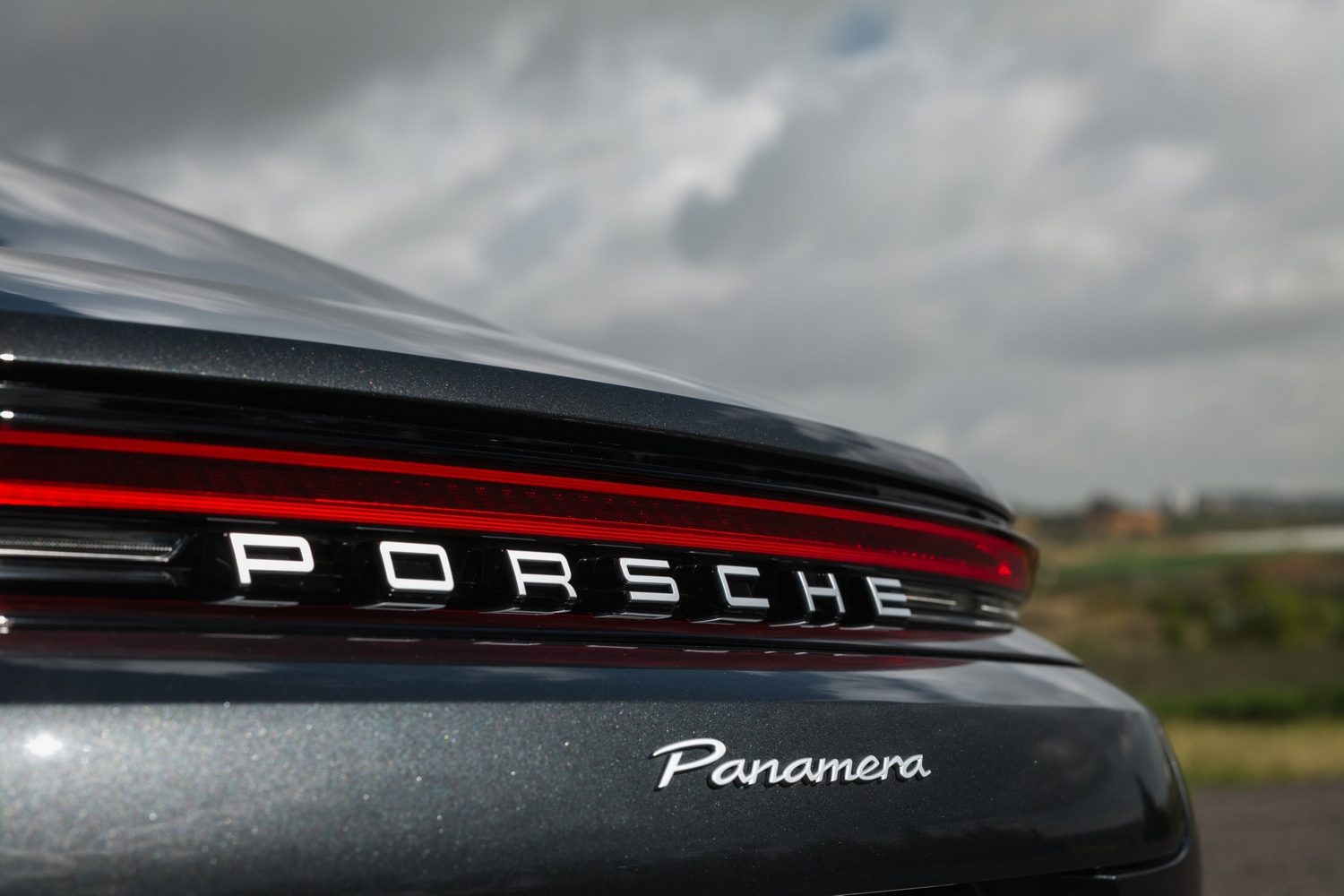Porsche Panamera 2024 review: This isn't engineering, it's witchcraft
Prepare to rub your eyes in disbelief
On a broad, flat apron of tarmac a Porsche Panamera Turbo E-Hybrid — the flagship of the new third-generation’s range — sits stationary, idling in the watery sunlight, two small cones flanking its wings.
In front of it, around 50 metres ahead of where it is quietly brooding on its impromptu start line, there’s a low, yellow, plastic set of bumps, an artificial construct designed to simulate lumpen tarmac. Even with the UK’s well-known level of sub-par road investment, you’d never realistically encounter a surface as lunar in its aspect as this.
For the first half of this test, the pronounced humps over which the Panamera’s wheels will be travelling are parallel. There’s then a brief pause of a few car lengths where it’s flat in the middle before another section of bumps that are alternately spaced on each wheel track. Basically, this is testing a car’s suspension to absolute, borderline unrealistic extremes.

Madeira Gold run
Up at the cones, the test driver in the Turbo E-Hybrid flattens the throttle to elicit full off-the-line acceleration; this in a grand tourer that has four-wheel drive, maximum power of 671bhp and a 0-62mph time of a just 3.2 seconds.
So, what you’re expecting to happen is for the rear of the Panamera to dip down as it scrabbles furiously off the line, as the sudden maximum power deployment transfers all of its 2.3-tonne-plus kerb weight backwards.
But it doesn’t. It stays preternaturally flat.

This spooky motoring magic trick then gets even more gobsmacking when the Panamera hits the bumps that have been laid out before it. Travelling at a steady 31mph, which is far, far quicker than you’d ever want to hit such extreme bumps, its 21in alloy wheels start a bonkers fandango in the arches, thundering up and down at the maximum of their suspension travel. Meanwhile, though, the body of the car is resolutely, almost comically flat — unaffected by what’s going on beneath it.
The Panamera Turbo E-Hybrid then ghosts its way off the the end of the construct, performs an elegant U-turn — aided by the optional rear-wheel steering — and proceeds to drive up in front of the gawping crowd of onlookers most sedately.
And then, as soon as someone opens one of its doors, the whole car immediately rises up on its tiptoes by 5.5cm to aid ingress and egress. If we didn’t know that the Panamera featured some clever new suspension technology, then we might wonder if this car is in fact possessed.
Porsche Active Ride: black magic
This Panamera is fitted with something called “Porsche Active Ride” (PAR). And it’s little short of witchcraft.
We get further, frankly baffling demonstrations of PAR’s otherworldly prowess. More full-bore standing starts, this time getting to speeds of much more than 31mph, are performed. The Panamera, a five-metre-long goliath with an SUV-like mass to counteract, does some high-speed slalom turns, jinking left-right-left at about 50mph. It even does two full-on emergency stops, triggering the anti-lock braking system and making its hazard lights frenetically flash as if it’s about to be involved in an accident.

And, throughout it all, the body of this PAR-equipped model stays flat. It simply will not move a millimetre. No pitching back. No diving forward. No excessive roll in the corners. It’s as if someone has created an ultra-realistic motorsport video game and forgotten to add the code that determines the physics of the car’s movement.
To hammer home the advantages of PAR, we watch another Turbo E-Hybrid without it fitted go through the same motions on the slalom course and you can see the shell of the juddering about noticeably as it performs the test.
Brain-melting stuff
Next we climb inside the golden PAR car and do the course again. As a passenger in the front seat you’re thrown around like a rag doll by the forces involved in giving this supremely powerful car full acceleration, the slalom and then an all-anchors-on emergency stop. Yet the steady view out of the windscreen of the Porsche doesn’t move an inch. When we drive it ourselves, over the bumps and round the same test course, we still can’t fathom how it is managing to stay freakishly level throughout it all.

Out on a race circuit we discover just how good the basic handling set-up on the cars is, but at the end, on the cool-down laps, we can focus on the PAR’s ability to lean the body of the vehicle into turns by up to three degrees, as a motorcyclist would do. We can feel it pressing its nose down as we accelerate hard, to prevent the front of the car rearing up, and it squats backwards when you brake to counteract the immense forces being flung forward. It is utterly eerie. And phenomenal.
There’s even a demo car sitting outside the pits, which Porsche’s PR team has rigged up so it can dance on the spot — showing the full range of movement of its wizardry, like one of those old American low-riders bouncing up and down on its suspension. Sadly for those who like the sounds of this function, it won’t be part of the companion app for the car, so don’t get your hopes up — it was purely for demo purposes.
You’ll need the Panamera plug-in hybrid
Porsche Active Ride is only going to be available on the E-Hybrid Panameras in the third-generation line-up. This is because it needs their 48-volt plug-in-hybrid electrical system to power the magic in the suspension. It uses one massive air chamber “spring” at each corner of the car, with one of the company’s adaptive dampers.
So effective is the PAR system that Porsche entirely removes the physical anti-roll bars on the Panameras with it fitted — they simply don’t need them anymore.

The alternative, standard option, is hardly basic. Technically-minded readers will want to know that they’re two-chamber adaptive air springs with Porsche Active Suspension Management (PASM) two-valve dampers — a suspension set-up recently employed on the recently-facelifted Cayenne SUV — but for everyone else it’s enough to know that the Panamera without PAR is by no means a rolling mess in the corners.
Having pummelled the Turbo E-Hybrid around the circuit, longer test drives involved two models at the other end of the Panamera line-up: the pair of variants that don’t come with plugs.
Panamera 2 and Panamera 4
The regular Panamera, which we’d have once called the “Panamera 2”, on account of it being two-wheel drive, has a 2.9-litre, twin-turbo V6 under the bonnet, sending 348bhp to the rear end through an eight-speed automatic (PDK dual-clutch) transmission. It costs from £79,500.

For another three grand, you can have the Panamera 4. Same drivetrain in essence, only it also sends grunt to the front wheels as part of its Porsche Traction Management all-wheel-drive system.
Despite weighing 35kg more than the rear-drive model and having a 1mph lower top speed in the ballpark of 170mph (purely an academic stat unless you regularly use the autobahn), the traction advantages of the Panamera 4 are enough to see it running a faster 0-62mph time.
With Sport Chrono equipped, an optional feature that brings in launch control, the Panamera 4 does the benchmark sprint in 4.8 seconds. Don’t tick the Sport Chrono box at ordering time, and it can still achieve 0-62mph in five seconds dead.
Both of those times are two-tenths of a second faster than the rear-wheel-drive, base-model Panamera’s stats, but unless you live in a place that has regular snowfall, we’d probably advocate going with the latter because there’s precious little between them. You don’t really notice any significant advantages or disadvantages to the Panamera 4, save for the fact it’s a little less playful in the corners than the two-wheel-drive model. In short, your additional £3,000 purchase outlay doesn’t bring any notable dynamic rewards.
Dynamically gifted
Whichever of the new Panameras you go for, you’re getting one of the finest big sports GTs of all time. The handling is fantastic. The ride comfort, while always on the informative side of comfortable (as befits a car from Porsche), is superb. The steering is out-of-this-world good — there are many sports cars that are less engaging than this.

OK, in Sport Plus mode, the PASM dampers get a little bit too keen, and some abrupt vertical movements of the body start to manifest when you hit bumps in the road.
And on the worst of road surfaces, the back of the Panamera’s cabin can become filled with the boomy resonance of excessive tyre roar. But that’s the exception, not the rule.
At all other times, the Panamera is an absolute delight to travel in. It’s such a cohesive, of-a-piece car in every regard. It is, in truth, a proper Porsche, and a proper superstar of long-distance motoring.
Marginal beauty gains once more
There are more benefits to opting for the third-gen Panamera. For instance, it looks good on the outside now. Granted, that was true of the Mk2 it has just replaced, and in fairness the latest version doesn’t look massively different to the old car — same crisp flanks, same full-width light strip at the back, same fastback profile (Porsche describes it as a saloon but the tailgate hinges at the top of the rear screen, so it isn’t).
However, at the front, a squared-off central intake is now teamed with a wide vent-like strip in the bumper, while the wings have been given a more pronounced curvature to mimic the 911’s, a characteristic that’s evident both from the kerbside and when you’re driving it — they frame your vision of the road ahead more prominently now.
One sad note for fans of load-luggers: there won’t be a gorgeous Sport Turismo estate of this generation of Panamera. Regrettably, sales of the old one were too slow (less than ten per cent of global uptake) and it didn’t even have a much bigger boot than the “saloon”. So it won’t make a comeback.
Cabin inspired by Taycan EV

Inside, the influence of the Taycan electric vehicle is obvious, with the Panamera following the updated Cayenne’s lead by adopting a 12.6in digital instrument cluster without a cowl. There’s also a 10.9in display for the central Porsche Communication Management (PCM — they do love an acronym) infotainment system and the option of another 10.9in display on the passenger-side dash if you want it.
Practicality is decent, because the Panamera has a massive amount of room between its front wheels and its rears. With nearly three metres between the front and rear axles, rear-seat occupants will have plenty of room for knees and heads.

Be warned, though, that as standard the Panamera is a four-seater. You can option a “4+1” layout, which adds another three-point belt in the middle of the back row, and gets rid of the covered cupholders for a seat squab, but the wide transmission tunnel in the Porsche means no one would want to sit there for long, so most will want to stick with the standard quartet of pews.
Boot space, which we already touched upon, is handy, with 494-1,328 litres available in these V6 models. The E-Hybrids — there are 464bhp 4 E-Hybrid and 537bhp 4S E-Hybrid to go with the Turbo range-topper — lose a bit of capacity, as their battery packs sit under the boot floor, resulting in equivalent stats of 421-1,255 litres.

Overall, though, the interior is a big hit, mainly because material quality is fabulous throughout, there’s good visibility out of the car in all directions (including through the narrow-looking rear screen), and Porsche ought to be given an award for its perfectly sized, perfectly shaped, gorgeous three-spoke steering wheel.
While the Panamera, on the face of it, isn’t a drastic departure from the model it has replaced, Porsche has carefully honed and polished what facets of it needed the most attention, to create a deceptively talented sports saloon.
But watch out for the ones fitted with Porsche Active Ride. They’re so well-versed in the dark arts of defying the laws of physics, it’s a wonder that people don’t consider burning them at the stake. This Porsche Panamera is capable of out-and-out sorcery, we tell you.
Related articles
- If you were interested in the new Porsche Panamera, you might also like to check out our track review of the Porsche Taycan GTS
- Porsche is busy this year — the new Porsche Macan will also be pure electric, and gets a 380-mile range and 630bhp
- Thinking of getting behind the wheel of a new vehicle this year, as a private or company car driver? Check out 11 of the most exciting new models arriving in 2024
Latest articles
- Should I buy a diesel car in 2025?
- F1 2025 calendar and race reports: The new Formula One season as it happens
- Zeekr 7X AWD 2025 review: A fast, spacious and high tech premium SUV — but someone call the chassis chief
- Denza Z9GT 2025 review: Flawed but sleek 1,062bhp shooting brake from BYD’s luxury arm
- Extended test: 2024 Renault Scenic E-Tech review
- Best-selling cars 2025: The UK’s ten most popular models of the year so far
- Audi A6 Avant 2025 review: Trusty executive estate ticks expected boxes, and there’s still a diesel option
- Keir Starmer eases pressure on carmakers to sell EVs in response to ‘global economic headwinds’
- Ferrari 12Cilindri Spider review: Heady blend of traditional and futuristic becomes even more intoxicating after lid is removed
























